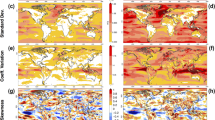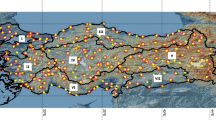Abstract
An assessment of the forecast quality of 10 m wind speed by deterministic and probabilistic verification measures has been carried out using the original raw and two statistical bias-adjusted forecasts in global coupled seasonal climate prediction systems (ECMWF-S4, METFR-S3, METFR-S4 and METFR-S5) for boreal winter (December–February) season over a 22-year period 1991–2012. We follow the standard leave-one-out cross-validation method throughout the work while evaluating the hindcast skills. To minimize the systematic error and obtain more reliable and accurate predictions, the simple bias correction (SBC) which adjusts the systematic errors of model and calibration (Cal), known as the variance inflation technique, methods as the statistical post-processing techniques have been applied. We have also built a multi-model ensemble (MME) forecast assigning equal weights to datasets of each prediction system to further enhance the predictability of the seasonal forecasts. Two MME have been created, the MME4 with all the four prediction systems and MME2 with two better performing systems. Generally, the ECMWF-S4 shows better performance than other individual prediction systems and the MME predictions indicate consistently higher temporal correlation coefficient (TCC) and fair ranked probability skill score (FRPSS) than the individual models. The spatial distribution of significant skill in MME2 prediction is almost similar to that in MME4 prediction. In the aspect of reliability, it is found that the Cal method has more effective improvement than the SBC method. The MME4_Cal predictions are placed in close proximity to the perfect reliability line for both above and below normal categorical events over globe, as compared to the MME2_Cal predictions, due to the increase in ensemble size. To further compare the forecast performance for seasonal variation of wind speed, we have evaluated the skill of the only raw MME2 predictions for all seasons. As a result, we also find that winter season shows better performance than other seasons.







Similar content being viewed by others
References
Acharya N et al (2013) On the bias correction of general circulation model output for Indian summer monsoon. Meteorol Appl 20:349–356
Alessandri A et al (2010) The INGV–CMCC seasonal prediction system: Improved ocean initial conditions. Mon Weather Rev 138:2930–2952
Amin M (2013) Energy: the smart-grid solution. Nature 499:145–147
Barnston AG, Mason SJ, Goddard L, DeWitt DG, Zebiak SE (2003) Multimodel ensembling in seasonal climate forecasting at IRI. Bull Am Meteorol Soc 84:1783–1796. https://doi.org/10.1175/BAMS-84-12-1783
Brocker J, Smith LA (2007) Increasing the reliability of reliability diagrams. Weather Forecast 22:651–661
Buontempo C et al (2014) Climate service development, delivery and use in Europe at monthly to inter-annual timescales. Clim Risk Manag 6:1–5
Charles A et al (2011) Comparison of techniques for the calibration of coupled model forecasts of Murray Darling Basin seasonal mean rainfall. CAWCR Tech Rep No. 040. http://www.cawcr.gov.au/technical-reports/CTR_040.pdf
Chevallier M, Salas-Mélia D (2012) The role of sea ice thickness distribution in the Arctic sea ice potential predictability: A diagnostic approach with a coupled GCM. J Clim 25(8):3025–3038
Clark RT, Bett PE, Thornton HE, Scaife AA (2017) Skilful seasonal predictions for the European energy industry. Environ Res Lett 12:024002
Coelho CAS, Costa SMS (2010) Challenges for integrating seasonal climate forecasts in user applications. Curr Opin Environ Sustain 2:317–325. https://doi.org/10.1016/j.cosust.2010.09.002
Daan H (1985) Sensitivity of verification scores to the classification of the preditand. Mon Weather Rev 113:1384–1392
Daget N, Weaver AT, Balmaseda MA (2009) An ensemble three-dimensional variational data assimilation system for the global ocean: sensitivity to the observation- and background-error variance formulation. Q J R Meteorol Soc 135:1071–1094
Dee DP et al (2011) The ERA-interim reanalysis: configuration and performance of the data assimilation system. Q J R Meteorol Soc 137:553–597
Déqué M et al (1999) ARPEGE version 3, documentation algorithmique et mode d’emploi (in French). CNRM/GMGEC, Toulouse
Doblas-Reyes FJ, Hagedorn R, Palmer TN (2005) The rationale behind the success of multi model ensembles in seasonal forecasting—II. Calibration and combination. Tellus A 57:234–252
Ebinger J, Vergara W (2011) Climate impacts on energy systems: key issues for energy sector adaptation. World Bank. https://openknowledge.worldbank.org/handle/10986/2271
Epstein ES (1969) A scoring system for probability forecasts of ranked categories. J Appl Meteorol 8:985–987
Feddersen H, Navarra A, Ward MN (1999) Reduction of model systematic error by statistical correction for dynamical seasonal predictions. J Clim 12:1974–1989
Ferro CAT (2014) Fair scores for ensemble forecasts. Q J R Meteorol Soc 140:1917–1923
Ferro CAT, Richardson DS, Weigel AP (2008) On the effect of ensemble size on the discrete and continuous ranked probability scores. Meteorol Appl 15:19–24
Foley AM et al (2012) Current methods and advances in forecasting of wind power generation. Renew Energy 37:1–8. https://doi.org/10.1016/j.renene.2011.05.033
Frankfurt School-UNEP Collaborating Centre (2016) Global trends in renewable energy investment 2016, pp 1–84. http://fs-unep-centre.org/publications/global-trends-renewable-energy-investment-2016
Hagedorn R, Doblas-Reyes FJ, Palmer TN (2005) The rationale behind the success of multi-model ensembles in seasonal forecasting—I. Basic concept. Tellus A 57:219–233
IPCC (2012) Renewable energy sources and climate change mitigation: special report of the intergovernmental panel on climate change. Cambridge University Press, Cambridge, United Kingdom and New York, NY, USA
Jeong HI, Lee DY, Ashkok K, Ahn JB, Lee JY, Luo JJ, Schemm JK, Hendon HH, Braganza K, Ham YG (2012) Assessment of the APCC coupled MME suite in predicting the distinctive climate impacts of two flavors of ENSO during boreal winter. Clim Dyn 39:475–493
Jeong HI, Ahn JB, Lee JY, Alessandri A, Hendon HH (2015) Interdecadal change of interannual variability and predictability of two types of ENSO. Clim Dyn 44:1073–1091
Johnson C, Bowler N (2009) On the reliability and calibration of ensemble forecasts. Mon Weather Rev 137:1717–1720
Jolliffe IT, Stephenson DB (2003) Forecast verification: a practitioner’s guide in atmospheric science. Wiley, Hoboken (ISBN: 0-471-49759-2)
Kharin VV, Zwiers FW (2002) Climate predictions with multimodel ensembles. J Clim 15:793–799
Kharin VV, Zwiers FW, Teng Q, Boer GJ, Derome J, Fontecilla JS (2009) Skill assessment of seasonal hindcasts from the Canadian Historical Forecast Project. Atmos Ocean 47:204–223
Kirtman BP, Min D, Infanti JM et al (2014) The North American multimodel ensemble: phase-1 seasonal-to-interannual prediction; phase-2 toward developing intraseasonal prediction. Bull Am Meteorol Soc 95:585–601. https://doi.org/10.1175/BAMS-D-12-00050.1
Koletsis I, Kotroni V, Lagouvardos K, T.Soukissian (2016) Assessment of offshore wind speed and power potential over the Mediterranean and the Black Seas under future climate changes. Renew Sustain Energy Rev 60:234–245
Krishnamurti TN et al (2000) Multimodel ensemble forecasts for weather and seasonal climate. J Clim 13:4196–4216
Kug JS, Lee JY, Kang IS (2008) Systematic error correction of dynamical seasonal prediction of sea surface temperature using a stepwise pattern project method. Mon Weather Rev 136:3501–3512. https://doi.org/10.1175/2008MWR2272.1
Langford S, Hendon HH (2013) Improving reliability of coupled model forecasts of australian seasonal rainfall. Mon Weather Rev 141:728–741
Lee DY, Ashok K, Ahn JB (2011) Toward enhancement of prediction skills of multimodel ensemble seasonal prediction: a climate filter concept. J Geophys Res 116:D06116. https://doi.org/10.1029/2010JD014610
Lee DY, Ahn JB et al (2013) Improvement of grand multi-model ensemble prediction skills for the coupled models of APCC/ENSEMBLES using a climate filter. Atmos Sci Lett 14:139–145. https://doi.org/10.1002/asl2.430
Lee DY, Ahn J-B, Yoo J-H (2015) Enhancement of seasonal prediction of East Asian summer rainfall related to western tropical Pacific convection. Clim Dyn 45:1025–1042
Leung LR et al (1999) Simulations of the ENSO hydroclimate signals in the pacific Northwest Columbia River Basin. Bull Am Meteorol Soc 80:2313–2329
Madec G, Delecluse P, Imbard M, Levy C (1998) Opa 8 ocean general circulation model—reference manual. Tech. rep., LODYC/IPSL Note 11
Meteo France (2015a) Météo-France seasonal forecast system 5 for Eurosip: technical description, pp 1–38
Meteo France (2015b) Météo-France seasonal forecast system 5 versus system 4: robust scores, pp 1–5
Michaelsen J (1987) Cross-validation in statistical climate forecast models. J Clim Appl Meteorol 26:1589–1600
Min Y-M, Kryjov VN, Park C-K (2009) A probabilistic multimodel ensemble approach to seasonal prediction. Weather Forecast 24:812–828. https://doi.org/10.1175/2008WAF2222140.1
Molteni F et al (2011) The new ECMWF seasonal forecast system (System 4). ECMWF Technical Memoranda, No. 656
Morse AP et al (2005) A forecast quality assessment of an end-to-end probabilistic multi-model seasonal forecast system using a malaria model. Tellus A 57:464–475
Murphy AH (1971) A note on the ranked probability score. J Appl Meteorol 10:155–156
Murphy AH (1988) Skill scores based on the Mean square error and their relationships to the correlation coefficient. Mon Weather Rev 116:2417–2424
Palmer BTN (2000) A probability and decision-model analysis of PROVOST seasonal multi-model ensemble integrations. Q J R Meteorol Soc 126:2013–2033
Palmer TN et al (2005) Probabilistic prediction of climate using multi-model ensembles: from basics to applications. Philos Trans R Soc Lond B Biol Sci 360:1991–1998
Pan J, Van den Dool H (1998) Extended-range probability forecasts based on dynamical model output. Weather Forecast 13:983–996
Pavan V, Doblas-Reyes FJ (2000) Multi-model seasonal hindcasts over the Euro-Atlantic: skill scores and dynamic features. Clim Dyn 16:611–625. https://doi.org/10.1007/s003820000063
Peng P et al (2002) An analysis of multimodel ensemble predictions for seasonal climate anomalies. J Geophys Res 107:1–12. https://doi.org/10.1029/2002JD002712
Richardson DS (2001) Measures of skill and value of ensemble prediction systems, their interrelationship and the effect of ensemble size. Q J R Meteorol Soc 127:2473–2489
Royer JF, Cariolle D, Chauvin F, Déqué M, Douville H, Hu RM, Planton S, Rascol A, Ricard JL, Salas y Melia D, Sevault F, Simon P, Somot S, Tyteca S, Terray L, Valcke S (2002) Simulation des changements climatiques au cours du 21-e`mesie`cle incluant l’ozone stratosphe´rique (simulation of climatechanges during the 21-st century including stratospheric ozone). C R Geosci 334:147–154
Torralba V et al (2017) Seasonal climate prediction: a new source of information for the management of wind energy resources. J Appl Meteorol Clim 56:1231–1247. https://doi.org/10.1175/JAMC-D-16-0204.1
Troccoli A et al (2010) Weather and climate risk management in the energy sector. Bull Am Meteorol Soc 91:785–788
Troccoli A et al (2013) Promoting new links between energy and meteorology. Bull Am Meteorol Soc 94:ES36–ES40. https://doi.org/10.1175/BAMS-D-12-00061.1
Vladislavleva E et al (2013) Predicting the energy output of wind farms based on weather data: Important variables and their correlation. Renewable Energy 50:236–243
Voldoire A et al (2013) The CNRM-CM5.1 global climate model: description and basic evaluation. Clim Dyn 40:2091–2121
Wang B et al (2008) How accurately do coupled climate models predict the leading modes of Asian–Australian monsoon interannual variability? Clim Dyn 30:605–619
Weigel AP, Liniger MA, Appenzeller C (2008) Can multi-model combination really enhance the prediction skill of probabilistic ensemble forecasts? Q J R Meteorol Soc 134:241–260
Weigel AP et al (2010) Risks of model weighting in multimodel climate projections. J Clim 23:4175–4191
Weisheimer A et al (2009) ENSEMBLES: a new multimodel ensemble for seasonal-to-annual predictions—skill and progress beyond DEMETER in forecasting tropical Pacific SSTs. Geophys Res Lett 36:L21711. https://doi.org/10.1029/2009GL040896
Wilks DS (2006) Statistical methods in the atmospheric sciences. Elsevier, Amsterdam, p 627 (ISSN 0074-6142)
Yang D, Yang X-Q, Xie Q, Zhang Y, Ren X, Tang Y (2016) Probabilistic versus deterministic skill in predicting the western North Pacific-East Asian summer monsoon variability with multimodel ensembles. J Geophys Res 121:1079–1103. https://doi.org/10.1002/2015JD023781
Yun WT et al (2005) A multi-model superensemble algorithm for seasonal climate prediction using DEMETER forecasts. Tellus A 57:280–289
Acknowledgements
This research was funded by the Spanish Ministry of Economy (MINECO) under the framework of the RESILIENCE project (CGL2013-41055-R). We are grateful to ECMWF and Météo France as the supporting institutions that provide with climate prediction datasets.
Author information
Authors and Affiliations
Corresponding author
Additional information
Publisher’s Note
Springer Nature remains neutral with regard to jurisdictional claims in published maps and institutional affiliations.
Electronic supplementary material
Below is the link to the electronic supplementary material.
Rights and permissions
About this article
Cite this article
Lee, D.Y., Doblas-Reyes, F.J., Torralba, V. et al. Multi-model seasonal forecasts for the wind energy sector. Clim Dyn 53, 2715–2729 (2019). https://doi.org/10.1007/s00382-019-04654-y
Received:
Accepted:
Published:
Issue Date:
DOI: https://doi.org/10.1007/s00382-019-04654-y




